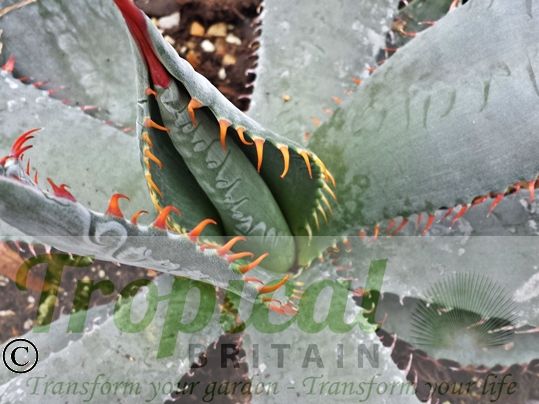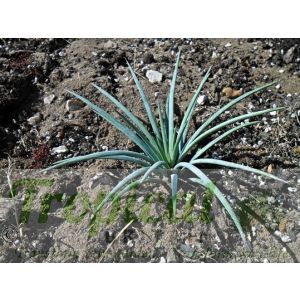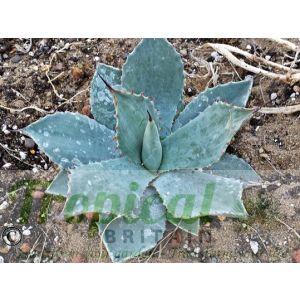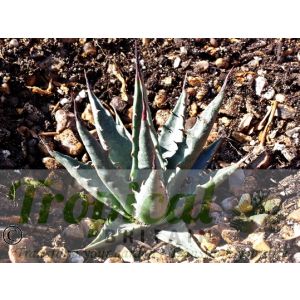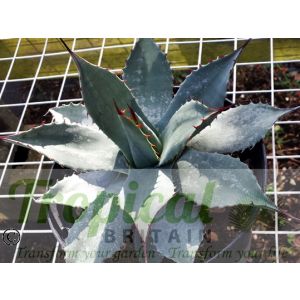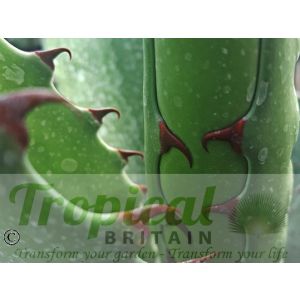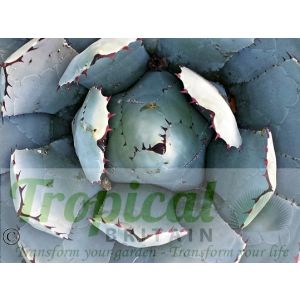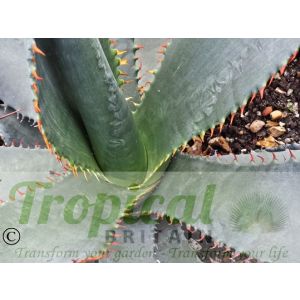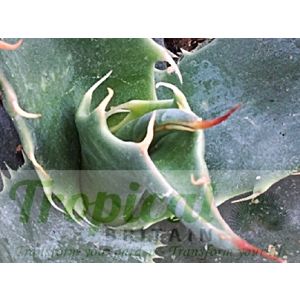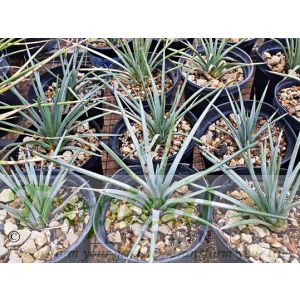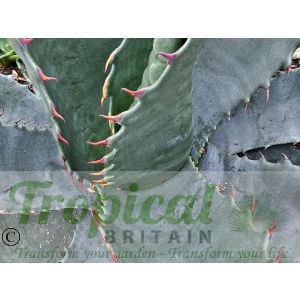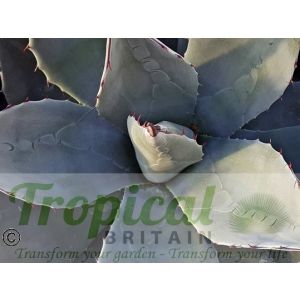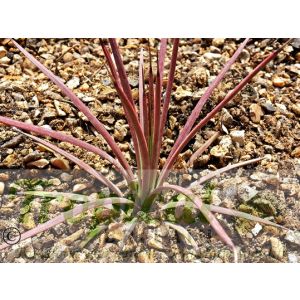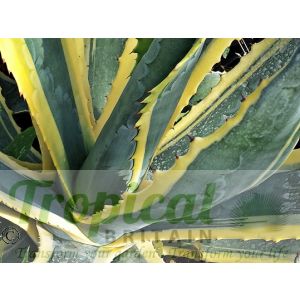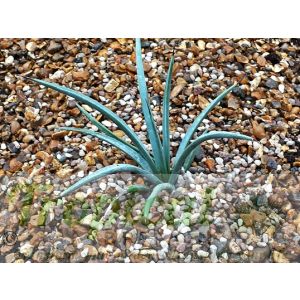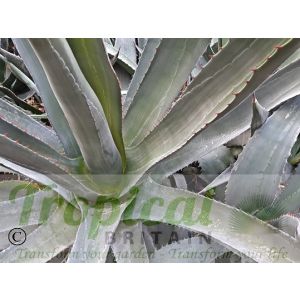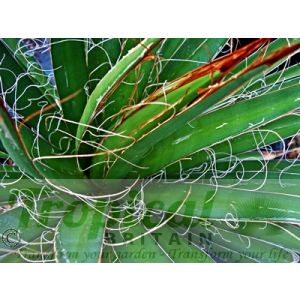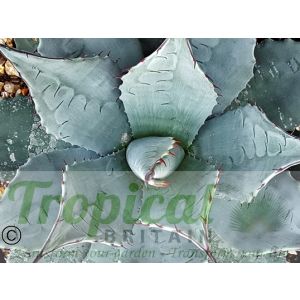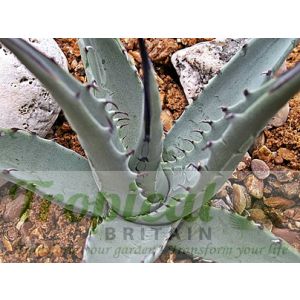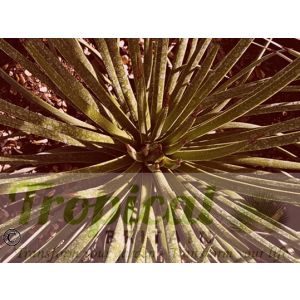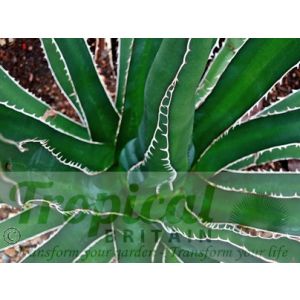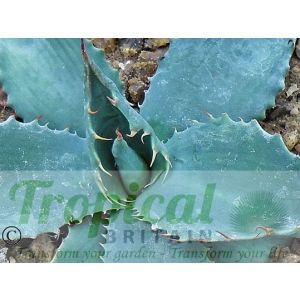Agave havardiana
- Hardy Agave
- Medium to large architectural form
- Full sun
- Perfect drainage
Agave havardiana is another wonderful cold-hardy Agave that with care and the correct cultivation will survive in UK gardens through the cold wet rigours of a British winter. The key - as with all the cold-hardy succulents - is to ensure they have perfect drainage with little soil so that rainwater quickly passes past their roots and doesn't stand.
Agave havardiana is native to the Trans-Pecos area in southwestern Texas where it is found in the Chisos Mountains and north in the Davis Mountains and further north into the Guadalupe Mountains in Hudsbeth and Culberson Counties and on into New Mexico. South, across the Rio Grande in Mexico, it is found in both Chihuahua and Coahuila States. It grows at higher elevations to about 2000 m on rocky gravelly grassland slopes, often in association with Dasylirion leiophyllum and Nasella tenuissima but as well as more open areas it can be found amongst desert scrub and higher into pinyon-juniper forest and oak woodland with surrounding vegetation of Texas madrone (Arbutus xalapensis), pine, juniper, walnut and oak. The predominant soils throughout the Chihuahuan Desert are an alkaline calcerous mix of gravel, sand and rock with very little moisture retention and on the slopes - where there is more actual soil - the drainage is increased by the gradient.
Agave havardiana is a medium to large sized, strikingly dramatic Agave with a bold architectural form. It has grey-green leaves that with age become increasingly silvery-grey giving it an almost luminous presence which contrasts strongly with the dark brown-black terminal spine. Its leaves are broader and more chalky in colour to Agave parryi var. parryi which it superficially resembles and it is an altogther larger and more imposing plant. It is also faster growing than Agave parryi - and unlike Agave parryi - it usually forms a solitary rosette although on occasion it does produce offsets.
In the wild Agave havardiana will sometimes hybridise with the other predominant Trans-Pecos Agave, the Shindagger, Agave lechuguilla to form Agave × glomeruliflora.
Along with Agave lechugilla and Agave parryi var. neomexicana, Agave havardiana was traditionally an important resource for the Mescaleros Apache who broke down its toxic steroid saponins in earth ovens and used the resultant molasses-flavoured sugars both as a food source and as a fermented base for the alcoholic drink, Mescal.
We have a limited quantity of this fast-growing rarely-offered Agave.
Now available in this larger 3L size. Great value!
Also available in smaller 1.5 Litre pots here
Additional Information
| Order | Asparagales |
|---|---|
| Family | Asparagaceae |
| Sub-Family | Agavoideae |
| Geographical Origin | Trans-Pecos region of southwest Texas, north in the Guadalupe mountains of New Mexico and South into Chihuahua and Coahuila in Mexico |
| Cultivation | Full sun. Perfect drainage at all times with a very free-draining alkaline substrate, ideally on a raised desert bed of gravel and sand or on a slope |
| Eventual Height | 1.3m |
| Eventual Spread | 1.3m |
| Hardiness | Will withstand bone-chilling temperatures down to -25 C but must be kept perfectly dry at the roots. Horticultural fleece and a secured rain-sheet will give extra protection during the winter |

Free DELIVERY
ON ALL ORDERS OVER £99THIS OFFER IS VALID ON ALL OUR STORE ITEMS.
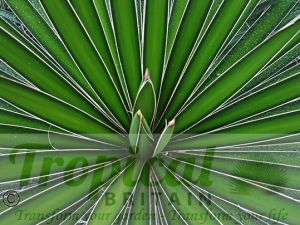
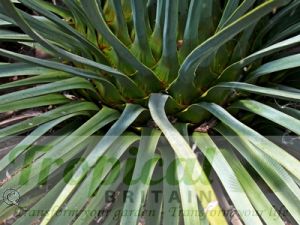
THE PLANTS
- Smaller-Growing Succulents
- Aeonium
- Agave
- Agave americana
- Agave amica
- Agave chrysantha
- Agave cupreata
- Agave deserti
- Agave filifera
- Agave gentryi
- Agave gomezpompae
- Agave havardiana
- Agave horrida ssp horrida
- Agave lechuguilla
- Agave mitis var mitis
- Agave montana
- Agave palmeri
- Agave parryi
- Agave polianthiflora
- Agave striata
- Agave stricta Rubra
- Agave toumeyana
- Agave univittata
- Agave utahensis
- Agave victoriae-reginae - Huasteca Canyon
- Aloe
- Beschorneria
- Bryophyllum
- Dasylirion
- Furcraea
- Hesperaloe
- Hesperoyucca
- Nolina
- Yucca
- Astrophytum
- Austrocylindropuntia
- Brasiliopuntia brasiliensis
- Cereus
- Chamaecereus silvestrii
- Cleistocactus
- Cumulopuntia
- Cylindropuntia
- Echinocereus
- Echinopsis
- Epiphyllum
- Ferocactus
- Gymnocalycium
- Hatiora
- Kroenleinia grusonii
- Lophocereus
- Maihuenia
- Mammillaria
- Matucana
- Myrtillocactus geometrizans
- Opuntia
- Opuntia arenaria SB964
- Opuntia atrispina
- Opuntia basilaris
- Opuntia chisosensis SB992 Brewster Co, TX
- Opuntia cymochila - Brewster Co, TX
- Opuntia engelmannii var. sandia
- Opuntia erinacea
- Opuntia fragilis
- Opuntia humifusa
- Opuntia lindheimeri - Beeville, TX
- Opuntia phaeacantha
- Opuntia pottsii var. nova DJF1441 SW Albuquerque, NM
- Opuntia robusta
- Opuntia sandiana
- Opuntia sanguinicola
- Opuntia stricta
- Opuntia strigil
- Opuntia trichophora
- Oroya peruviana
- Parodia
- Polaskia
- Rhipsalis
- Schlumbergera
- Stenocactus
- Stetsonia
- Tephrocactus
- Alocasia
- Amorphophallus
- Arisaema
- Arum
- Calla
- Caladium
- Colocasia
- Dracunculus
- Monstera
- Helicodiceros muscivorus
- Philodendron
- Pinellia
- Remusatia
- Sauromatum
- Spathantheum
- Typhonium
- Xanthosoma
- Zantedeschia

